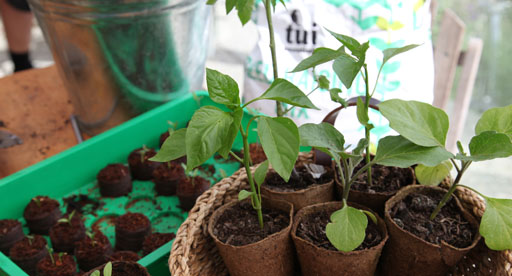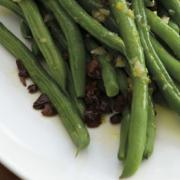
Before you actually put food on the table (well most foods that you might actually want to eat!) it has to grow. And while gardening may not seem in any way like cooking, the parallel is that it’s easy to feel overwhelmed when you’re just starting out. But both cooking and gardening are skills quickly learnt by doing.
Green Beans with Olives and Garlic
Prep time: 5 mins
Cook time: 7 mins
Serves: 6 as a side
Ingredients
- 500g green beans, trimmed
- 2 tbsp olive oil
- 2 cloves garlic, crushed
- finely grated zest and juice of ½ a lemon
- 2-3 tbsp finely chopped kalamata olives
Method
- Drop beans into boiling water and cook for 3 minutes.
- Refresh under cold water and drain without shaking off all the water (you want them wet so they cook evenly later).
- Heat olive oil in a frypan and gently fry garlic, lemon zest and a little salt for one minute without browning.
- Add olives and beans and cook over a medium-low heat until warmed through (1-2 minutes). If they dry out and start to brown, add a little water.
- Transfer to a serving plate, season to taste with salt and ground black pepper and drizzle with lemon juice to serve.
To get a healthy plant producing, by knowing how deep the hole should be, what kind of soil to use, how often to water it and how long it will take to grow, can seem quite daunting initially. But then you notice things just popping up by themselves, seeds that may have fallen or been blown onto a path, not just coming up but growing vigorously, and you realise this is what nature does. Seeds are programmed to grow, so all they need is a little help from us.
Success in the garden is just a matter of finding the right conditions for each plant type. Some seeds are best planted directly into the soil – carrots for example, and peas, don’t like their roots to be disturbed. But lots of other things do better if you get the seed started inside, especially at this time of the year when it can still be nippy outdoors.
I like to start vegetables like cucumbers, pumpkins, zucchini, peppers, eggplants, tomatoes in little coir pellets – it’s something my dad always did. Through the late winter and spring our night store heater always looked like a botany lab, with all Dad’s little containers of germinating seeds covered with Mum’s old plastic shower caps, rigged to stay warm and humid on those bitterly cold Wellington nights (the rest of the house was bloody freezing!).
These days it’s so much easier to grow from seed with the help of a mini greenhouse – just soak the coir pellets in water, pop a seed in each and slot them into your mini greenhouse. As long as you keep them moist and warm you will have little seedlings starting to germinate in a week to ten days.
Once the plants are three or four centimetres high, transplant the whole caboodle into slightly larger peat pots. By this stage your little plants will have used up all the reserves inside their seeds, so fill the pots up with vegetable mix and give them a good feed with Tui Organic Seaweed Plant Tonic. You’ll find a great step-by-step guide to growing from seed here
From seed to a plant ready for planting outdoors will take about a month to five weeks, depending on variety and temperatures, so work your seed planting schedule back from when you think it’s going to be frost-free outside. Peat pots, like coir pellets, are fully biodegradable, which means you can plant the whole thing directly into the soil without disturbing or stressing the roots.
For crops like beans I fill a mini greenhouse with seed-raising mix, plant a close grid of seeds, cover with a finger joint depth of seed-raising mix and then wait for them to pop up. This way I get a block of little plants that can be easily separated and transplanted into the garden when they are six or seven centimetres tall.
Once you have your plants out in the open ground, one of the best ways to ensure they stay happy and healthy is to water them with Seasol seaweed-based plant tonic every two to four weeks. Seasol contains potassium, which promotes thicker, stronger cell walls. This means the plants are more able to cope with stresses such as heat, drought and frost. The nutrients and naturally occurring growth stimulants in Seasol promote strong root growth, reduce transplant shock, improve germination rates and increase flowering and fruiting capacity. And all that in a natural product made from seaweed! Big plus!
One of the things I enjoy most about seed raising is being able to trial special varieties and heirloom seed types that I can’t buy as seedlings. It’s also a really good way to plant groups of plants from different cuisines.
Not only do these seed combinations supply you with a variety of veges rather than a glut of one thing, they also work as a natural plant protection method, as growing a variety of plants together makes them less likely to be attacked by insect pests.
Crops like tomatoes and eggplants, chillies and cucumbers can take three or four months to produce a harvest. With spring underway the clock is ticking, and in order for your plants to reach full maturity by the end of summer the seeds need to go in now. Like most good things in life, timing is everything.
Although best known as a cookbook author and publisher, Annabel Langbein is also a highly experienced and knowledgeable gardener. She studied horticulture at Lincoln University and for many years has grown her family’s fresh produce in her gardens and orchards in Wanaka and Auckland. Her seasonal harvests are the inspiration for many of the inventive but easy recipes in her cookbooks.
Read more of Annabel's guest blogs here
Post a comment
Annabel's October Growing Guide Comments
Be the first to write a comment